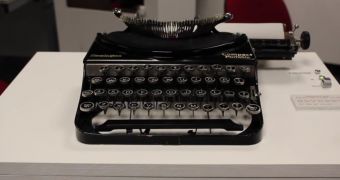Back in the 1930s, there weren't many computers to pass around, so people tended to make do with contraptions that were purely mechanical more often than not. Typewriters were a staple of those times, and it seems that some people want them to endure the passage of time.
Now it's true that turning them into museum pieces would accomplish that goal well enough, but that wasn't enough for Joe Hounsham from Plymouth University in the UK.
He wanted to give antiques a role in modern society, or at least give typewriters the chance to experience the spotlight again.
Considering that we're about to introduce you to his invention, we'd say that he succeeded in the secondary goal. Even he doesn't expect humanity to slide back from the digital age. However, he does know the value of nostalgia.
Behold the chat room typewriter
Technically, that's not the name of the product. That would be Dico. Nevertheless, the contraption's main asset is that it can let you converse with people in an Internet / network chatroom.
Hounsham had to install some electronic / computer parts in order to make this possible, since typewriters have none of their own.
Specifically, an Arduino microcontroller was used to control the solenoids that pull down the keys on the typewriter.
That's not all it does, though. The device also has motion tracking. A rudimentary sort, but enough to detect when someone approaches.
Once it senses a person coming close enough, the Dico automatically starts looking for a person to talk to, randomly chosen from those in the chat room.
All in all, it's an impressive senior project, and IBM agrees with us, since the company gave Housham the IBM Smarter Planet Award, thanks to how the Dico demonstrated "the technical qualities and imagination required to help make the world a Smarter Planet."
The video below shows the interactive typewriter in action. We must say that it's pretty cool to watch it work. If you agree and want one of your own, we're afraid that we'll have to disappoint you, since there are no plans to market the thing.
Fortunately, the IBM Business Mobile Insights blog has a fairly detailed walkthrough of how the student created it in the first place, so you might be able to recreate the process yourself. You'll need to be patient and diligent though. For our part, we'll stick to our trusty keyboards.

 14 DAY TRIAL //
14 DAY TRIAL // 